<<< back

|
Scroll down for english version
Przestrzeń publiczna to przestrzeń wolna, nieodpłatna, dostępna dla każdego. Sztuka wpisana jest w nią od zawsze. Pojawia się naturalnie, ale czy równomiernie?
Projekt "Under the bridge" był projektem o dwóch mostach zlokalizowanych w dość odległych od siebie miejscach - gdańskim Dolnym Mieście i liverpoolskim Garston. Co je łączy?
Estakada nad Church Road w Garston, peryferyjnej dzielnicy Liverpoolu, powstała w latach 80-tych jako część drogi prowadzącej do centrum miasta. Jej budowa zmieniła wizerunek dzielnicy.
Estakada przecięła Garston, podzieliła "żywy organizm" na dwie wyraźnie odrębne części. Przestrzeń bliżej portu zmieniła się z typowego angielskiego przedmieścia w iście księżycowy krajobraz,
podlegający ciągłej transformacji - stare domy stopniowo wyburzane zastępują nowe, obszar poddawany jest intensywnej rewitalizacji.
Gdański most nad ulicą Szopy jest częścią trasy Podwale Przedmiejskiej - drogi szybkiego ruchu wytyczonej jeszcze podczas II Wojny Światowej.
Oddzieliła ona Dolne Miasto od reszty Gdańska, ugruntowując tym samym podziały na część historyczną i "biedniejszą", przemysłową.
Zwykła zdawać by się mogło decyzja planistów, w mikro skali okazała się być brzemienną w skutkach. Obydwa mosty stały się linią graniczną,
"przestrzeniami pomiędzy" - symbolicznym przejściem między dwoma nieprzystającymi (?) światami. Niczym w soczewce skupiają problemy dzielnic.
Ich przekroczenie porównać można do teleportacji - nagłego przeniesienia się w zupełnie inną czasoprzestrzeń.
Jak podziały przez nie wprowadzone wpływają na postrzeganie miejsca? Jak ćwiczą świadomość mieszkańców i przyjezdnych?
"Under the bridge" składał się z serii artystycznych interwencji w publiczną i "mentalną" przestrzeń dwóch mostów,
analizujących "podświadomości" dzielnic, w sposób symboliczny łączących dwie przestrzenie.
W 2009 roku w Gdańsku swoje pracy zrealizowali Ross Dalziel (29 sierpnia), Rita Slater (11 września),
Maeve Rendle (28 września - 2 października); w Liverpoolu w ramach obchodów POLSKA YEAR! Roman Dziadkiewicz (3-10 czerwca),
Elżbieta Jabłońska (11 lipca), Dorota Buczkowska (21 sierpnia do wyburzenia budynku), Łukasz Jastrubczak (25 września).
Artystyczne interwencje odbywały się raz w miesiącu. W projekcie celowo odeszliśmy od formy festiwalu w stronę bardziej ulotnych działań.
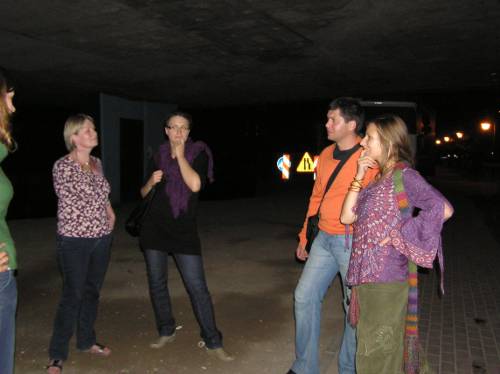 Rita Slater - Guerilla Karooke, Gdańsk 2009
Rita Slater - Guerilla Karooke, Gdańsk 2009
(...) "Miejska partyzantka" tak najkrócej opisać można projekt Rity Slater "Guerilla Karaoke".
11 września około północy artystka spotkała się pod mostem z grupą osób by wykonać kilka wspólnie
wybranych piosenek. Bezbronność ich głosów zderzona została z opresyjnością betonowej architektury.
Ludzki głos na moment zasiedlił przestrzeń niczyją, wykorzystał akustykę mostu, odwrócił funkcję budowli.
"Przestrzeń pomiędzy" stała się miejscem tajemniczego spotkania, świadkiem procesu tworzenia, budowania relacji,
chwilowym, bezpiecznym schronieniem przed oczami innych. Czy poprzez ulotny akt wokalnej partyzantki udało się
odzyskać przestrzeń, przywrócić jej utracony ludzki wymiar? Dźwiękowe graffiti artystki było próbą komunikacji
z drugim człowiekiem poza językową barierą i dwuznacznością słów. Kojarzyć się mogło również z dziecięcą zabawą,
daremną pogonią za uciekającym echem.(...)
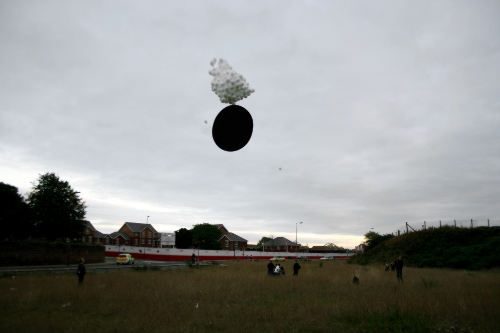
Łukasz Jastrubczak - Zaćmienie, Garston 2009, fot. Rita Slater
(...) Akcja Łukasza Jastrubczaka "Zaćmienie" przywodziła na myśl zamrożony filmowy kadr.
Przez godzinę 3-metrowe, czarne koło unosiło się nad Garston, budząc ciekawość okolicznych dzieci i przechodniów.
Praca Jastrubczaka wpasowała się całkowicie w krajobraz, dopełniając pobliską wieżę, kościół, most.
Czy zmieniła coś w mieszkańcach? Odczytać ją można jako odniesienie do swoistego letargu, w którym pogrążona jest dzielnica.(...)
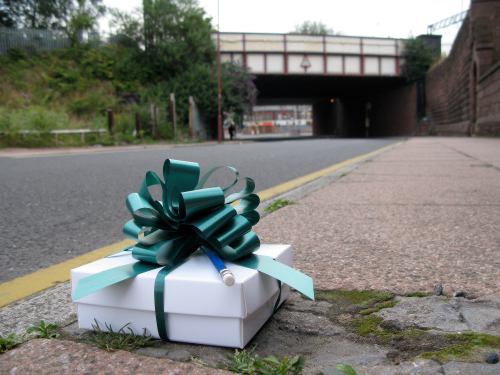
Elżbieta Jabłońska, Garston 2009, fot. Kevin Hunt
(...) Niemal niezauważalna, akcja Elżbiety Jabłońska była formą bezpośredniej pomocy dla mieszkańców Garston.
Rankiem, około 6 rano na ulicach, na stopniach domów lub parapetach pozostawione zostały prezenty.
W każdym z białych pudełek przyozdobionych dekoracyjną wstążką odnaleźć można było zestaw do przetrwania
w ciężkich warunkach - pudełko zapałek; świeczkę; sznurek; kaloryczny, czekoladowy baton; kartkę papieru;
ołówek. Prezenty rozłożone zostały równomiernie po obydwu stronach mostu, miały pomóc mieszkańcom
w wytrwaniu w trudnej sytuacji transformacji dzielnicy. Ciekawą reakcją była odpowiedź Louise Mills
zamieszczona następnego dnia na internetowym blogu Art in Liverpool, opisująca znalezienie prezentu.
Przeczytać w niej możemy:
""I spotted one of your lovely pristine white boxes, bound with silver ribbon,
a beautiful big bow and adorned with a sharpened blue pencil held in place by the ribbon,
nestling amongst some discarded rubbish that someone must have inconsiderately fly tipped a while ago.
Me being me, curiosity got the better of me. So whilst listening to the Ranger's talk about the old Bobbing
Factory on Blackburn Road, I removed the silver ribbon and bow and opened up the little white box,
not expecting to find anything of use or value inside at all. Imagine my surprise when I saw the contents.
I assume the Bryant & May matches represent the old Match Works that used reside not too far away
and the string maybe represents the old bobbin factory perhaps? I still haven't found the significance
of the tealight, blank lined notepaper or the chocolate coated caramel bar yet (but the chocolate
bar was rather tasty, so thanks)"
opis na blogu
(...) Projekt "Under the bridge" rozpoczął się w 2008 roku jako część projektu "For the Likes of Us..." Liverpool Biennale.
Liverpoolski festiwal jest stosunkowo młodą imprezą. Powołany do życia w 1998 roku w zeszłym roku obchodził
dziesięciolecie swego istnienia. Myślą przewodnią festiwalu jest "enganging art, people and places".
Ważne miejsce w programie imprezy zajmują realizacje w przestrzeni publicznej. Projekty Liverpool
Biennale nie koncentrują się tylko w centrum, festiwal stara się angażować cały obszar miasta również
dzielnice w języku developerskim określane jako "bad location", miejsca bez perspektyw, wymagające rewitalizacji.
Głównym celem projektu "For the Likes of Us..." była aktywizacja trzech zaniedbanych dzielnic - Kensington,
Kirkdale, Garston - poprzez projekty na granicy działań artystycznych i społecznych. Lokalnie działającym
organizacjom stworzono możliwość współpracy z międzynarodowymi artystami. Każdej z dzielnic w ramach projektu
przyporządkowane zostało miasto partnerskie w ramach sieci współpracy "Cities on the edge". Głównym celem projektu
"For the Likes of Us..." była rewitalizacja dzielnic poprzez sztukę, działania na granicy działań artystycznych i społecznych.(...)
fragmenty tekstu Agnieszki Kulazińskiej
Public space is free space available to everybody. Art has always been assigned to it. It comes naturally, but does it come evenly distributed?
The Under the Bridge project was about two bridges located quite remotely from each other in physical space - in Gdańsk Dolne Miasto (Lower Town)
and in Garston, Liverpool. What do they have in common?
The bridge over Church Road in Garston, a peripheral district of Liverpool, was built in the 1980s as part of a road
leading to Liverpool centre. Its construction, once complete, changed the area totally. The flyover has cut Garston,
a "living body", into two clearly separate parts. The part located close to the port changed from a typical
English suburb into a moonscape, subject to constant transformation - the old houses are slowly being pulled
down and replaced by new ones, and the area is undergoing intensive revitalisation.
The bridge in Gdańsk over Szopy Street is part of Podwale Przedmiejskie - a high speed road designed there
during the Second World War. It divided Lower Town (Dolne Miasto) from the rest of Gdańsk, thus cementing the
division into a historic part and a "poor" industrial part of the city.
A simple decision of city planners had a dramatic impact on the micro scale. Both bridges have become a border line,
a space in between - a symbolic transition between two incompatible (?) worlds. As under a magnifying glass the two bridges
show the problems of the districts. Having crossed the border line you feel as if teleported - you are suddenly transferred
to a completely different space in time. In what way do the divisions made by the bridges influence the perception of space?
What impact do they have on the consciousness of local people and of visitors?
The "Under the Bridge" project is about a series of artistic interventions in the public and "mental" space of two bridges, and seeks to analyse the subconscious of the district, symbolically linking two spaces.
In 2009 Gdańsk was a place of artistic works performed by Ross Dalziel (29 August), Rita Slater (11 September), and Maeve Rendle (28 September - 2 October). The artistic actions in Liverpool have been carried out under the POLSKA YEAR! by Roman Dziadkiewicz (3-10 June), Elżbieta Jabłońska (11 July), Dorota Buczkowska (from 21 August until the demolition of the building is completed), Łukasz Jastrubczak (25 September). The artistic interventions took place once a month. In our project we have chosen to move away from the festival form in the direction of more volatile actions.
 Rita Slater - Guerilla Karooke, Gdańsk 2009
Rita Slater - Guerilla Karooke, Gdańsk 2009
(...) "Urban Guerrillas" is a short description of Rita Slater's project entitled "Guerrilla Karaoke".
On 11 September, around midnight, the artist met under the bridge with a group of people to sing some
jointly selected songs. The defencelessness of their voices was confronted with the oppressiveness of
the concrete architecture. For a while, the unoccupied space was inhabited by the human voice, which made
use of the acoustics of the bridge and reversed the function of the bridge. The space "in between" became
the place of a mysterious meeting, a witness to the creative process, building of relations, and temporary
shelter from the eyes of other people. Has the space been regained by the volatile, vocal guerrilla act;
has the space regained its lost human dimension? The artist's sound graffiti was an attempt to communicate
with another human being beyond the language barrier and ambiguity of words. It also has some associations
with child's play, with a vain pursuit after a run-away echo.(...)

Łukasz Jastrubczak - Eclipse, Garston 2009, photo: Rita Slater
(...) The action by Łukasz Jastrubczak entitled "Eclipse" is reminiscent of a frozen movie frame.
For one hour a 3-metre black wheel was being raised over Garston, to the curiosity of children and passers-by.
Jastrubczak's work fitted perfectly in the landscape, thus completing the tower, the church and the bridge.
Has it changed anything in the people living there? We may read it a reference to the lethargy
which the neighbourhood has lapsed into.

Elżbieta Jabłońska, Garston 2009, photo: Kevin Hunt
The action by Elżbieta Jabłońska was a form of direct help for the people of Garston.
At 6 o'clock in the morning small gifts were left on the house stairs or window-sills.
In each of the white boxes decorated with silver there was a survival kit - a matchbox,
candle, string, chocolate energy bar, piece of paper, and a pencil. The boxes were distributed
evenly on both sides of the bridge. They were intended to support local people in the difficult
times of transformation. An interesting response came from Louise Mills, who published it next
day on the Art in Liverpool blog, describing how she found the gift. It reads as follows:
"I spotted one of your lovely pristine white boxes, bound with silver ribbon,
a beautiful big bow and adorned with a sharpened blue pencil held in place by the ribbon,
nestling amongst some discarded rubbish that someone must have inconsiderately fly tipped a while ago.
Me being me, curiosity got the better of me. So whilst listening to the Ranger's talk about the old Bobbing
Factory on Blackburn Road, I removed the silver ribbon and bow and opened up the little white box,
not expecting to find anything of use or value inside at all. Imagine my surprise when I saw the contents.
I assume the Bryant & May matches represent the old Match Works that used reside not too far away
and the string maybe represents the old bobbin factory perhaps? I still haven't found the significance
of the tealight, blank lined notepaper or the chocolate coated caramel bar yet (but the chocolate
bar was rather tasty, so thanks)"
original source
(...) The "Under the Bridge" project was begun in 2008 as part of another project entitled "For the Likes of Us..." Liverpool Biennale.
Liverpool Festival is a relatively young event. It was established in 1998 and last year it celebrated its ten year anniversary.
The festival's main concept is "engaging art, people and places". Events organised in public space play a very important role in the festival programme.
The Liverpool Biennale projects are not located only in the city centre; the festival has the ambition to involve the entire town, including areas
which in the developer's language are defined as a "bad location", places without good perspectives for the future, places in urgent need of revitalisation
programmes. The main objective of the "For the Likes of Us..." project was to activate three neglected districts - Kensington, Kirkdale and Garston -
by artistic and social projects. The local organisations had an opportunity to work together with international artists. Each district
in the project was matched with a partner city under the co-operation network "Cities on the Edge". The main objective of the
"For the Likes of Us..." project was to revitalise the city districts by art and social and artistic actions. Under co-operation between
Gdańsk and Garston three projects were organised in 2008. The projects were formulated as a result of a local context analysis.(...)
Quoted from the text by Agnieszka Kulazińska
|
sponsorzy
sponsors



miejsca festiwalu
festival veues





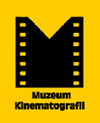



patroni medialni
media patronage



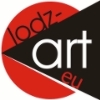



|
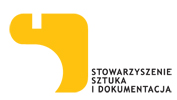
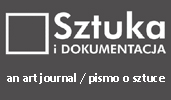




















 Rita Slater - Guerilla Karooke, Gdańsk 2009
Rita Slater - Guerilla Karooke, Gdańsk 2009
